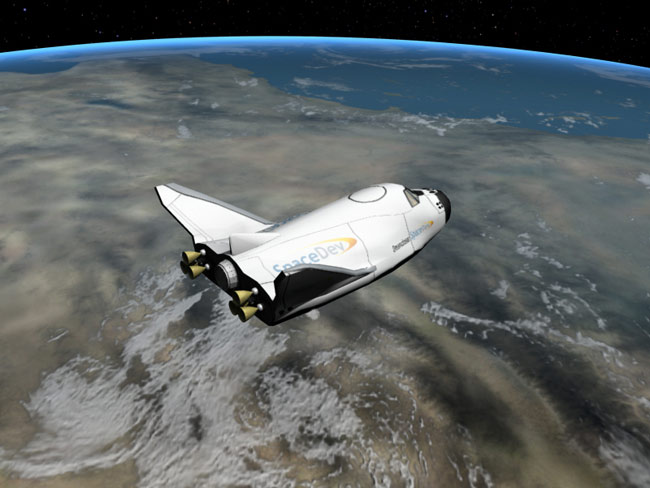Competition Heats Up for NASA's Space Cargo Contract

With NASA'sshuttle fleet to retireand a looming gap before a new spaceship debuts, the stage is set for privatefirms hoping to offer commercial cargo and crew services to the InternationalSpace Station (ISS).
Sixcontenders - from a field of more than 20 hopefuls - have weathered NASA's roundof culling for the Commercial Orbital Transportation Services (COTS) effort,with the first awards slated to be announced in August, according to somecompetitors. NASA plans to spend about $500 million on the COTS effort over thenext five years, the agency has said.
Among theteams that reportedly made the cut are:
- Andrews Space, a Seattle, Washington-based firm cited by industry sources as a finalist though company officials would not comment on the matter aside from stating they have received a response from NASA on their proposal.
- Oklahoma City-based Rocketplane Kistler - a cooperative effort between Rocketplane Limited and Kistler Aerospace - which is developing a payload launch and cargo ferrying vehicle around its K-1 rocket.
- SpaceDev, of Poway, California, which previously announced plans for a spaceplane dubbed Dream Chaser.
- El Segundo, California-based Space Exploration Technologies (SpaceX), which is developing its Dragon capsule system and Falcon 9 rocket to for cargo and crewed spaceflights.
- Spacehab, in Houston, Texas, where designs for the Apex 400 - largest in a trio of spacecraft - are underway to resupply the ISS.
- Reston, Virginia's Transformational Space Corp. (t/Space), which has lead a group of firms pursuing a crewed transfer vehicle (CXV) for NASA use, has also been cited by experts as a COTS finalist.
While someCOTS contenders have openly spoken of their selection as NASA finalists, others- such as Andrews Space and t/Space remain reticent since the competition is stillunderway. They are competing in four different arenas: a pressurized vehicle toferry cargo to and from the ISS, a pressurized variant that disposes of the spacecraft,unpressurized cargo to the station and disposal, and crew transportation,SpaceDev said.
Two other teams- Lockheed Martin and the joint Northrop Grumman-Boeing group - are competing ina separate race to build NASA's post-shuttle crewed spacecraft; the Crew ExplorationVehicle.
And thefinalists are...
At theheart of Rocketplane Kistler's COTS entry is the K-1 rocket, a two-stagebooster with reusable components and an orbital stage designed to carrydeployable satellites - or other payloads - as well as a cargo container forthe ISS.
Breaking space news, the latest updates on rocket launches, skywatching events and more!
Publishedspecifications call for a 121-foot (37-meter) rocket capable of launchingpayloads of nearly 11,023 pounds (5,000 kilograms) into low-Earth orbit,though Rocketplane Kistler officials said their effort has moved beyond thatspecified on Kistler's website. Other details indicate target launch sites fromthe Nevada Test Site outside Las Vegas and Woomera, Australia.
"It givesthe reader...a very good sense of how the vehicle operates and is appropriatelyout of phase with our development," Bob Seto, Rocketplane's vice president of engineeringsystems and analysis, told SPACE.com of the earlier documentation. "Theactual development is ahead, but it gives you the sense of where we were andprobably where we're going."
Out fromunder wraps
Meanwhile COTScompetitor SpaceX, led by entrepreneur Elon Musk, unveiled plans for itsreusable Dragon space capsule earlier this year.

"There aresome things I didn't talk about, that we're keeping closer to the vest, thatwill be of benefit to NASA," Musk said in a telephone interview, reiteratingthat human spaceflight was always on the SpaceX docket. "Really the major goalin the long run is human space transportation, that's the reason for the foundingof the company."
SpaceX keptits Dragon project under wraps while publicly moving ahead with its unmannedFalcon 1 effort since 2004, but reported that a prototype flight crew capsulehas already been built. While the prototype lacks a reaction control system orreentry heat shield, a life-support system for the vehicle has already beentested.
Thespacecraft is intended not to dock itself at the ISS, but user a laser-guided systemto maneuver near the station to be grappled with the outpost's robotic arm. Thecapsule can then be mated manually like NASA's shuttle-carriedcargo modules, to deliver supplies or new crewmembers.
Musk saidengine tests of the Falcon 9 flight engines could occur this December with thefirst launch to follow about one year later.
"There'reactually three Falcon 9 flights on schedule for 2008, with the NASA flights tofollow on top of that," Musk said, adding that some uncertainty is built intothat plan. "We'd have a three flight demonstration ending with a flight to theInternational Space Station."
Partnersand competitors
SpaceX isworking has reportedly partnered with several companies for its Dragon project,including fellow COTS competitor Spacehab. But that partnership hasn't preventedSpacehab from casting its own entry into the commercial space transportationring.
Lastsummer, Spacehab - which has been a staple provider of components for NASA'sshuttle system - announcedplans to develop a family of spacecraft dubbed Apex to cater to themicrosatellite and hefty payload needs of customers. The firm plans to moveahead with the project COTS or no COTS.
"Spacehabis committed to the Apex program as a whole," said Kimberly Campbell, Spacehab'svice president of corporate marketing, in a telephone interview. "Our goal isto provide continuous low-cost access to space."
The largestin the Apex arsenal, the 400 series, is Spacehab's bid for NASA's COTS contest.
Designed tolaunch atop an Atlas 5 or Delta 4 rocket, the spacecraft could haul payloads ofup to 27,000 pounds (12,300 kilograms into orbit, Spacehab has said. A modifiedversion equipped with a reentry system to return cargo or material to Earth - avaluable asset for ISS experiments - is expected to orbit 18,959 pounds (8,600kilograms), they added.
Spacehab'sApex 400 series tops the spacecraft family's payload charts, with specificationcalling for loads up to 27,000 pounds (12,300 kilograms) for one-way flightsand 18,959 pounds (8,600 kilograms) for returnable flights. The spacecraftcould launch atop an Atlas 5 or Delta 4 rocket, Spacehab officials said.
"It's aboutproviding an end-to-end service," Spacehab's Apex program manager Jim Bakertold SPACE.com of the Apex 400's multiple booster plan. "If we're tiedto one specific launch vehicle, than if that launch vehicle has issues orproblems, or is down, than our business is impacted."
Orbitaldreams
SpaceDevofficials have said in the past that they hoped their Dream Chaser vehicle wouldprove a strong candidate for ISS resupply and crew rotation flights, thoughwhether the vehicle will be modified for NASA's COTS program is unclear.
Initiallyunveiled as anevolution of the NASA's X-34 vehicle designed, SpaceDev lateropted for a blunt-nosed spacecraft to carry passengers or crew onsuborbital or orbital treks. The spacecraft is expected to launch verticallyatop a stack of hybrid rocket engines and make runway landings upon Earthreturn. It is small enough - with wings folded -to fit in the payload bay of aNASA shuttle.
"Ouremployees, project team members, and subcontractors are thrilled to have beenchosen as a finalist ," SpaceDev chief Mark Sirangelo said in a statement onNASA's COTS program.
Paststatements have said the spacecraft could haul a limited crew and one ton ofcargo into Earth orbit.

An AndrewsSpace spokesperson would not comment on the Seattle firm's COTS effort andt/Space officials did not return phone messages but projects by both companieshint at what their bids may entail.
AndrewsSpace recently won an U.S. Air Force contract to define architectures for a flexiblehybrid launch vehicle capable of sending payloads ranging from 2,000 pounds (907kilograms) to 60,000 pounds (27,215 kilograms) into various orbits within a 48-hourperiod.
Publishedstatements on the firm's website indicate that Andrews has developed a "familyof vehicles that are capable of addressing existing and emerging commercial andgovernment markets." The firm also studied design requirements for a shuttlealternative vehicle to deliver and return cargo to the ISS under a past NASA-sponsoredproject.
"Under the contract, Andrews evaluated for recoveringcargo as well as transporting up to 48,700 kilograms of cargo per year," thefirm states on its website.

Whoeverwins out in NASA's COTS competition, there is no shortage of ideas for orbitalspacecraft.
"I'm verypragmatic as far as what gets us to affordable space transportation and have noparticular predilection towards private or government funding," Musk said. "Ijust want it to happen."
Join our Space Forums to keep talking space on the latest missions, night sky and more! And if you have a news tip, correction or comment, let us know at: community@space.com.

Tariq is the award-winning Editor-in-Chief of Space.com and joined the team in 2001. He covers human spaceflight, as well as skywatching and entertainment. He became Space.com's Editor-in-Chief in 2019. Before joining Space.com, Tariq was a staff reporter for The Los Angeles Times covering education and city beats in La Habra, Fullerton and Huntington Beach. He's a recipient of the 2022 Harry Kolcum Award for excellence in space reporting and the 2025 Space Pioneer Award from the National Space Society. He is an Eagle Scout and Space Camp alum with journalism degrees from the USC and NYU. You can find Tariq at Space.com and as the co-host to the This Week In Space podcast on the TWiT network. To see his latest project, you can follow Tariq on Twitter @tariqjmalik.
